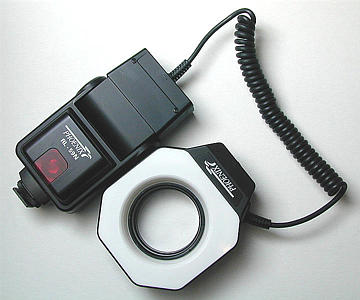
|
| A low-cost ring flash: Phoenix RL-59 |
Ring flashes are very popular in close-up photography. They usually consist of two parts. The shoe-mount unit is for mounting the flashes on a hot-shoe, and the circular flash unit to be mounted in front of a lens. See the image below. Power is supplied by the batteries in the shoe-mount unit, and a cord relies the power and control signals to the circular flash unit. Within the circular flash unit, there can be one or more flash tubes, each of which can be turned on or off individually. Some ring flashes even have focusing lamps for helping low-light focusing. Why do we need more than one flash tubes? As will be shown later, ring flashes produce very even and flat illumination to the subjects. To create a more three-dimensional feeling, we can turn some flash tubes off so that lighting is not so flat. Moreover, since sometimes part of the flash may be blocked by unavoidable objects thereby creating shadows in the image, we can turn off the blocked flash tube to eliminate these unwanted shadows.

|
| A low-cost ring flash: Phoenix RL-59 |
Ring flashes are known for their capability of producing shadowless images as illustrated below. If the subjects are small enough that can be covered within the area of the circular flash tube, then every point will be illuminated from all directions. As a result, shadows are canceled out. However, if the flash is close enough to the subjects or the subjects are large, shadows around the outer boundaries may be strong enough to become visible.

|
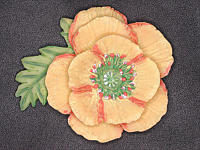
|
| Click on an image to see a larger one | |
The back-end of the circular flash tube of a ring flash has a thread to be used for mounting in front of a lens. One of the advantages of using a ring flash is that the flash and the lens have the same direction when the flash is mounted in front of a lens. Of course, a ring flash does not have to be mounted on a lens; but, this will defeat the purpose of using a ring flash to produce shadowless images. If your lens has a filter thread different from that on a ring flash, step-up rings are required. The thread size of a ring flash is usually 49mm, 52mm, 55mm or 58mm for mounting on some older SLR macro lenses. Most ring flashes come with a number of rings so that they can be mounted on lenses with different filter thread sizes. Some macro lenses may have larger thread sizes (e.g., Nikon's 60mm, and 200mm have thread size 62mm), and, hence, require a larger flash unit opening. Nikon's ring flash SB-29 has an opening of 62mm.
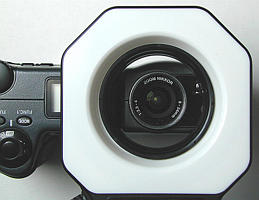
|
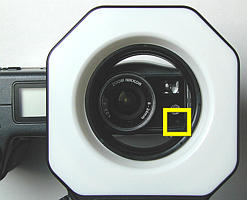
|
| A ring flash and the on-camera lens | Problem with 950/990 |
However, mounting a ring flash on a 950 or 990 does cause problems. As shown in the left image above, the opening of the ring flash is much larger than the diameter of the on-camera lens. Thus, step-up rings are required. In the case of 950 and 990, since the filter thread size is 28mm, you might think a 28-37mm step-up ring followed by a 37mm step-up ring would solve the problem. Unfortunately, it is not going to work. Look at the left image above. The flash tube partially blocks the flash sensor and hence using step-up rings will completely block the sensor. The location of this flash sensor of a 950 and 990 is one the major user-unfriendly problems. Therefore, to get a correct flash exposure, the flash tube must be moved all the way to the right to uncover the flash sensor. See the right image above. Problem? Yes, we will likely to have un-even illumination.
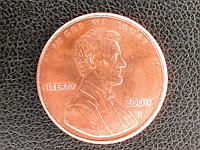
|
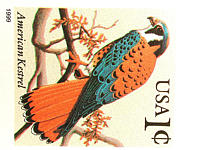
|
| Click on an image to see a larger one | |
This un-even illumination problem is more serious when the camera is very close to your subject. The above images illustrate this problem. The right edge in each image is brighter than the left edge. Let us see why this happens. As you can see from the following diagram, if we have to expose the flash sensor, the circular flash tube and the lens will not have the same center. In fact, the right side of the flash tube is closer to the subject than the left side is. As a result, the right side of the subject receives more light than its left side does and hence the right side of the subject becomes brighter. To overcome this un-even illumination problem, you could use a ring flash with which you can fine tune the output power of each individual flash tube. Or, you could buy a ring flash with larger center opening so that the lens and the circular flash tube will have the same center.
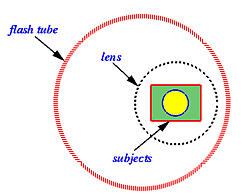
There is another problem here. For extremely close-up situations, the flash sensor is not at the center of the image and it may measure the wrong spot. This is a common problem of non-TTL (i.e., through the lens) meters.
Because ring flashes are mostly used for close-up, their GNs are usually small, perhaps less than 50 (in feet). This means a ring flash is not supposed to be used in longer distance. If we want depth, we might choose to use a smaller aperture, and, as a result, the effective distance of using a ring flash is about 1 to 2 feet. In fact, most ring flashes are designed to be effective in this range. If the flash is too far away, we need to use larger aperture and will likely get under-exposed images. Worse, in longer distance a ring flash simply becomes a point light source and all advantages of using a ring flash disappear. On the other hand, if the flash is too close to the subject, we may be forced to use very small aperture and will likely get over-exposed images. Coolpix 950's and 990's amazing 2cm close-up working distance is infeasible in many situations, because the smallest available aperture is F11.0. Here is why. Suppose we have a ring flash with GN 50 in feet and wish to maximize the depth of field by using the smallest available aperture F11.0. Thus, the effective distance is 50/11=4.5 ft, which is much larger than the 2cm closest focus distance in close-up mode. If we move the camera very close to the subjects, say less than 1 ft, we will definitely get over-exposed images unless your ring flash's power can be turned down. Thus, this "2cm" working distance instantly becomes a disadvantage!
The following are some examples. Note that all images are adjusted only for brightness and contrast. Some images actually need color balance adjustments.
The first set of images is close distance copying. A ring flash sheds an even illumination on the stamp surface, and, the results are very good, except that the right edges are usually brighter than the left edges due to a problem of positioning the circular flash tube discussed earlier.
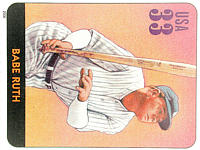
|
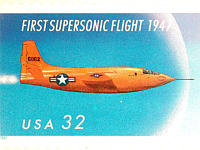
|
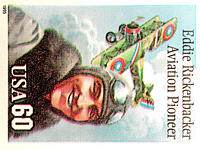
|
| Click on an image to see a larger one | ||
The second set of images demonstrates document copying. The size of the logo in the first image below is 2cm×1.8cm and the working distance is about 2.5cm. As a result, the image was over-exposed; but, because the paper appears to be reasonably white, no brightness adjustment is needed. The second is a copy of the TC-E3ED's manual and the third one is a copy of one of my warranty cards. The camera-subject distance is about 13.5cm in both cases. Because the background color appears to be gray in the original images, limited brightness adjustment was applied. Note that the paper color is not white. As you can see from these images, ring flashes perform very well in copying documents.
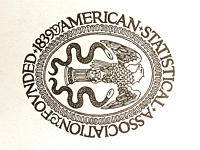
|

|
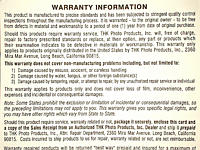
|
| Click on an image to see a larger one | ||
Coins are reasonably flat. Because they are small and reflexive, the camera-subject distance is short and over-exposure is likely. Brightness adjustments are needed for the images below. Moreover, because the ring flash is very close to the subject and is not centered, the right edge of each image is brighter than the left edge as discussed earlier.
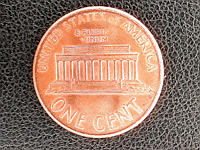
|
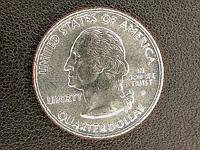
|

|
| Click on an image to see a larger one | ||
The following are images of a number of 7cm×5cm magnets. Their surfaces are not flat and as a result the texture can clearly be seen. Since the whole magnet is illuminated evenly, the results look more three-dimensional.

|
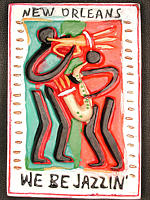
|

|
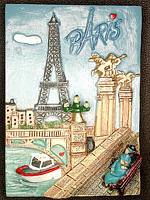
|
| Click on an image to see a larger one | |||
Finally, the following are six images of small non-flat items.
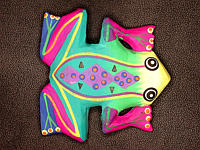
|
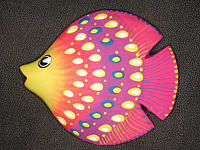
|
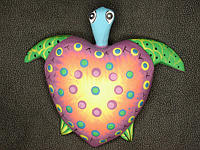
|

|
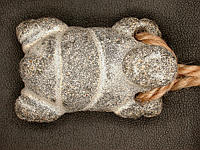
|
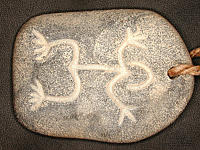
|
| Click on an image to see a larger one | ||
You might want to ask the following question: how is a ring flash compared against the internal flash and/or an external flash? For the case of external flash, we need to use two to generate an even illumination like a ring flash does. However, since the camera-subject distance is so short, it is difficult to position these external flashes. The internal flash does not work well either due to the same reason. The following images illustrate this effect. As you can see, only one side of the image can be illuminated properly. Therefore, even though the flash sensor of a Coolpix 950 and 990 may not be perfect, for extreme close-up photography, using a ring flash still gives better results than using the internal flash or an external flash.
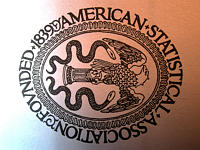
| 
| 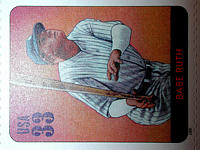
|